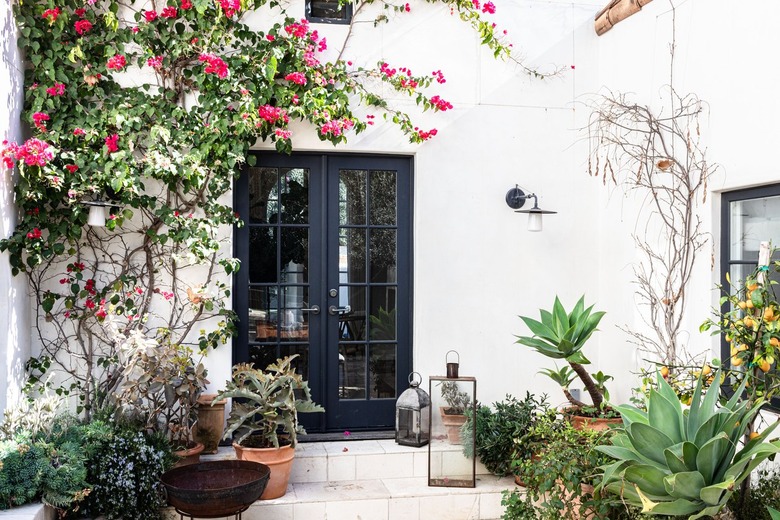7 Easy Updates For Your Healthy Home
We may receive a commission on purchases made from links.
Home has become much more than the place where we crash at the end of the day — it's also transformed into our office, our classroom, our gym, and our full-on entertainment zone. Because we're spending so much time in our houses (about a 27% increase in waking hours per day from 2019 to 2020, according to the 2020 American Time Use Survey), it's become crucial to optimize our spaces for health and wellbeing.
This doesn't mean you have to spring for a home gym or sauna, or even convert a spare bedroom into a serene yoga lounge. There are small updates you can easily make to contribute to your home's health and safety.
1. Incorporate a water filter.
1. Incorporate a water filter.
Filling our reusable water bottles, giving the kids or fur babies a bath, making a cup of tea — water is central to any household. Unfortunately, according to Scientific American, a majority of United States households have contaminated tap water that can cause a slew of health issues. An easy way to combat this is to add a water filtration system into your home. You can accomplish this via either point-of-use water filters (like under-the-sink water filters or water pitchers you can pop in the fridge) or a whole-house water filter, which decontaminates water in the entire plumbing supply.
2. Upgrade to hygienic touchless faucets.
2. Upgrade to hygienic touchless faucets.
Touchless faucets are a game changer when it comes to maintaining clean, germ-free cooking and washing spaces. Keeping your kitchen or bathroom hands-free means not only will you never have to touch your faucet with germy hands again, but you'll also be helping to conserve water in your home. Though installation is a bit trickier than with a traditional faucet, there's no denying how much cleaner and easier touchless faucets make life at home. Plus, imagine how smooth your cooking and cleaning flows will be.
3. Add soundproofing features in your bedroom.
3. Add soundproofing features in your bedroom.
It turns out that hearing loud outdoor noises when you're trying to wind down is more than just irritating — it's also bad for your health. According to the EPA, noise pollution can contribute to higher levels of stress, hearing loss, sleep disruption, and high blood pressure. No one wants that. To remedy this, use DIY soundproofing methods like adding a rug, hanging blackout curtains, and sealing any gaps in the floors or ceilings with caulk.
4. Use low- or no-VOC paint for your next project.
4. Use low- or no-VOC paint for your next project.
Painting a room is one of the simplest — and cheapest — ways to completely transform it. Unfortunately, a lot of paint contains volatile organic compounds (or VOCs), which are harmful gasses that can cause unexpected problems for both humans and the environment. Luckily, you can easily make a switch to a low- or no-VOC paint for your next project. Examples include Sherwin-Williams Harmony Interior Acrylic Latex, Valspar Simplicity, and Clare, a direct-to-consumer paint company that offers an entire line of no-VOC paint.
5. Consider gardening with only native plants.
5. Consider gardening with only native plants.
If you have a garden, it's tempting (and let's face it, easier) to just pick out whatever eye-catching plants you find at your local gardening center. While any type of plant can spruce up your garden and create a miniature ecosystem for birds, bugs, and small critters, native plants are much easier to care for, and they do not require fertilizers or pesticides (which can be harmful to your health) to encourage growth. Planting this type of flora is also a great way to restore ecological balance in your area.
6. Replace caulking in the bathtub.
6. Replace caulking in the bathtub.
It's likely that you never think about the caulking in your bathtub — until you notice that it's suddenly started to look moldy and produce a musty scent. While fear of black mold is often overhyped, mold can definitely be irritating if you're prone to allergies or have asthma. Luckily, in about an hour and for less than $10, you can easily replace the caulking in your bathtub or shower to create a clean look and prevent water damage issues as well as mold and mildew.
7. Decant pet food to prevent pest problems.
7. Decant pet food to prevent pest problems.
It turns out that your pet isn't the only one who likes to chow down on their kibble. Rodents and other pests can't resist that open bag of dog or cat food sitting in the garage or laundry room because it contains proteins and fats that they need. And since pests like mice and rats carry diseases and gnaw on electrical cables, we don't have to tell you twice why you want to avoid having them in your home.
To prevent tempting pests with your dog or cat's food, store their chow in an airtight storage container. This will prevents infestations while keeping your pet's food fresh.
